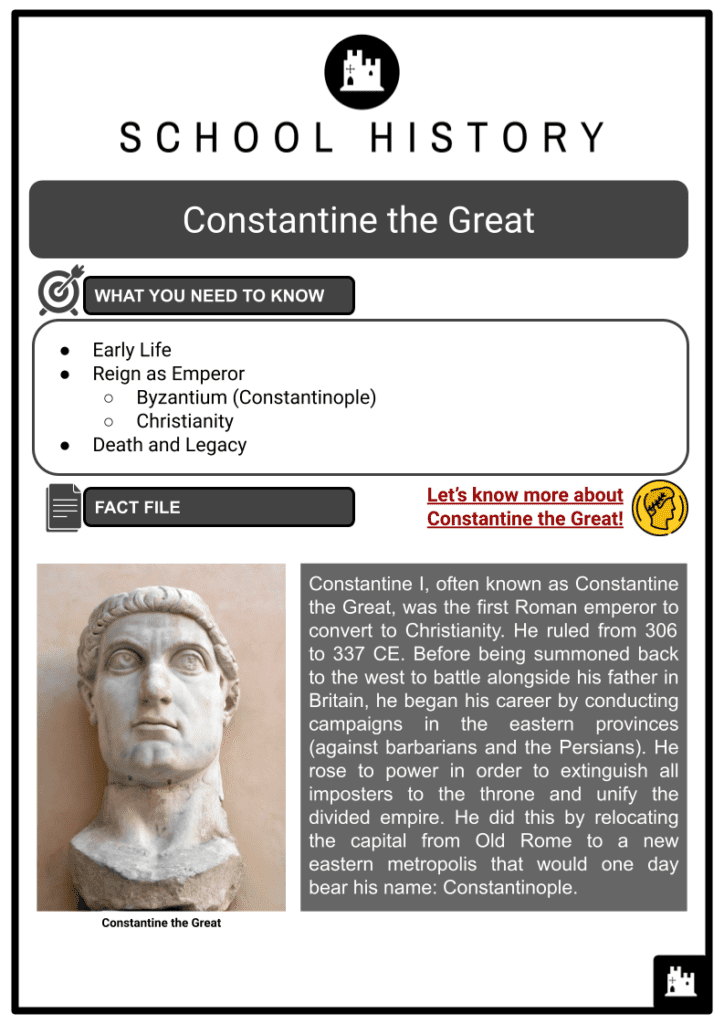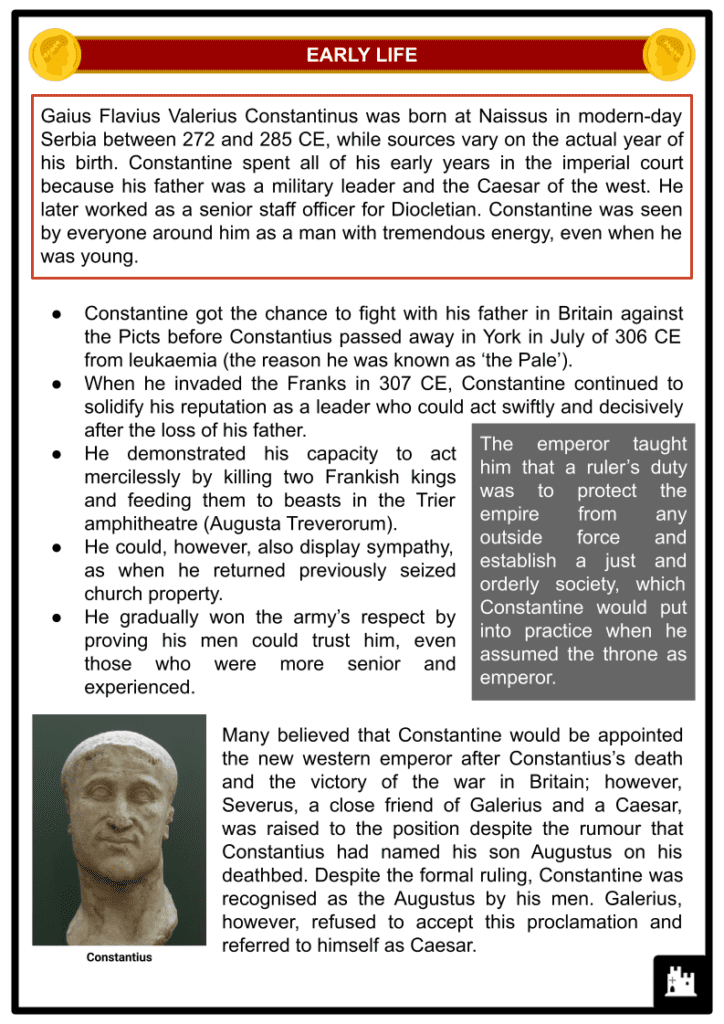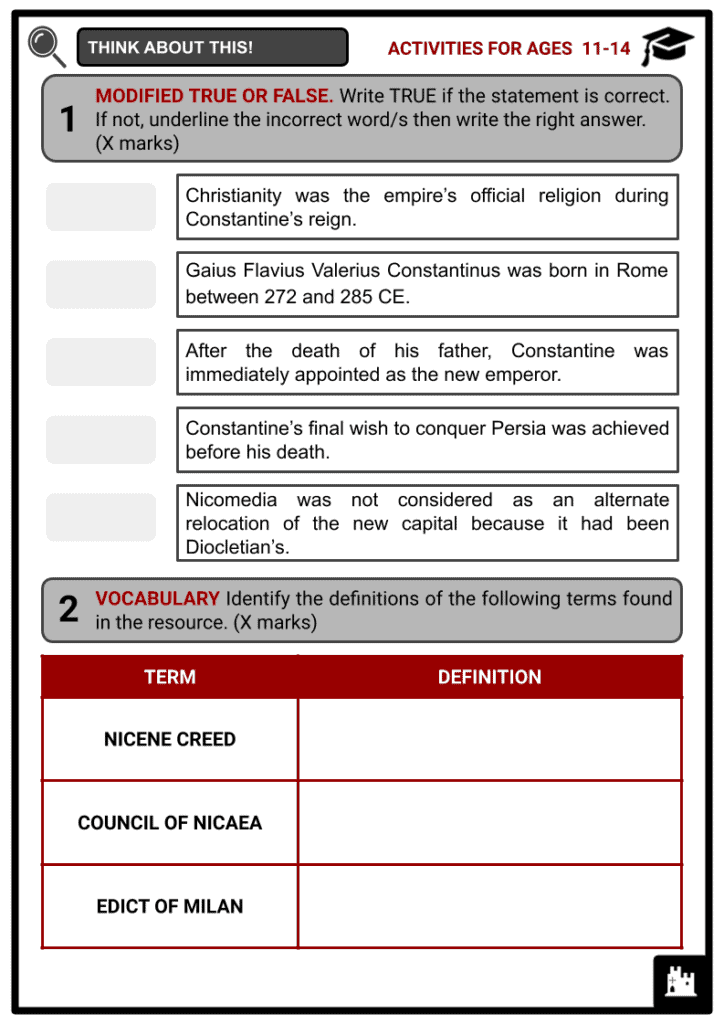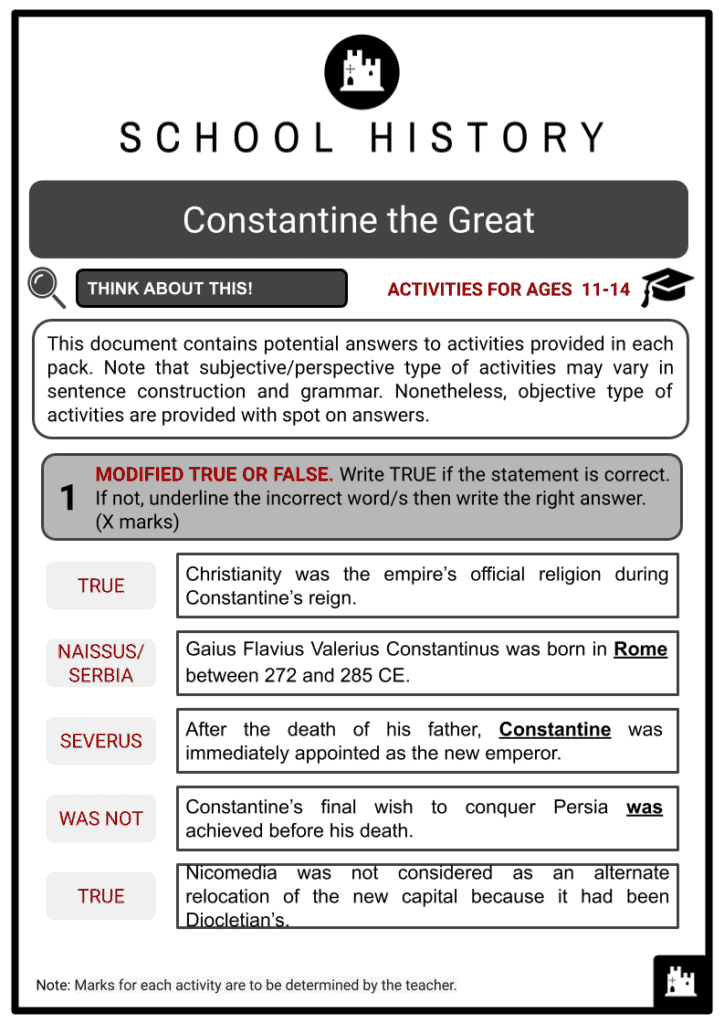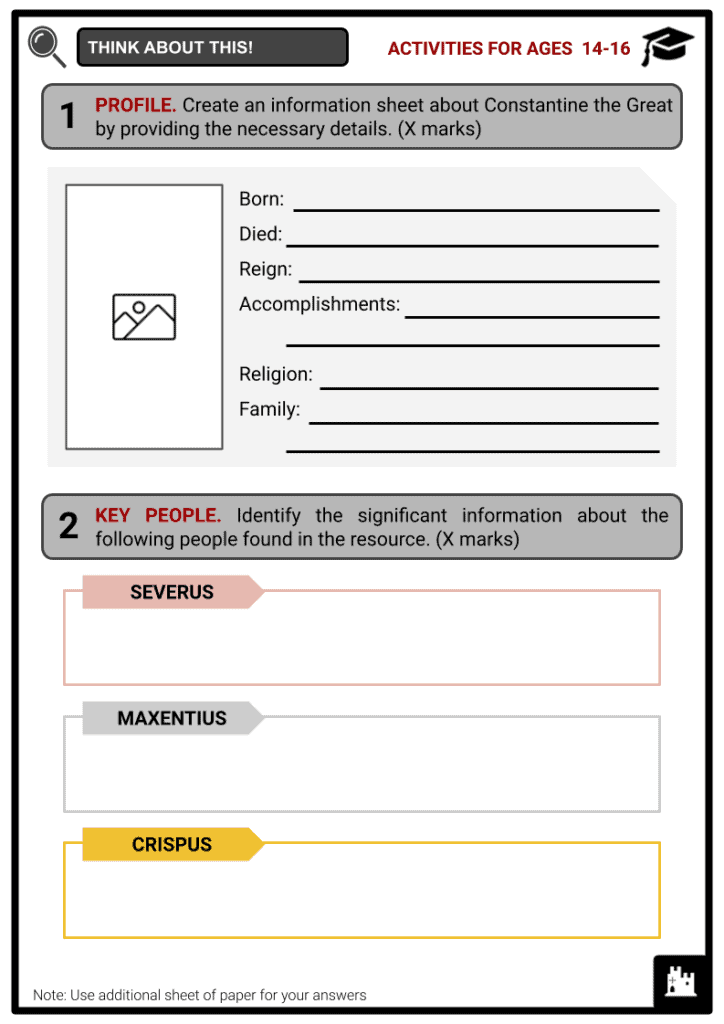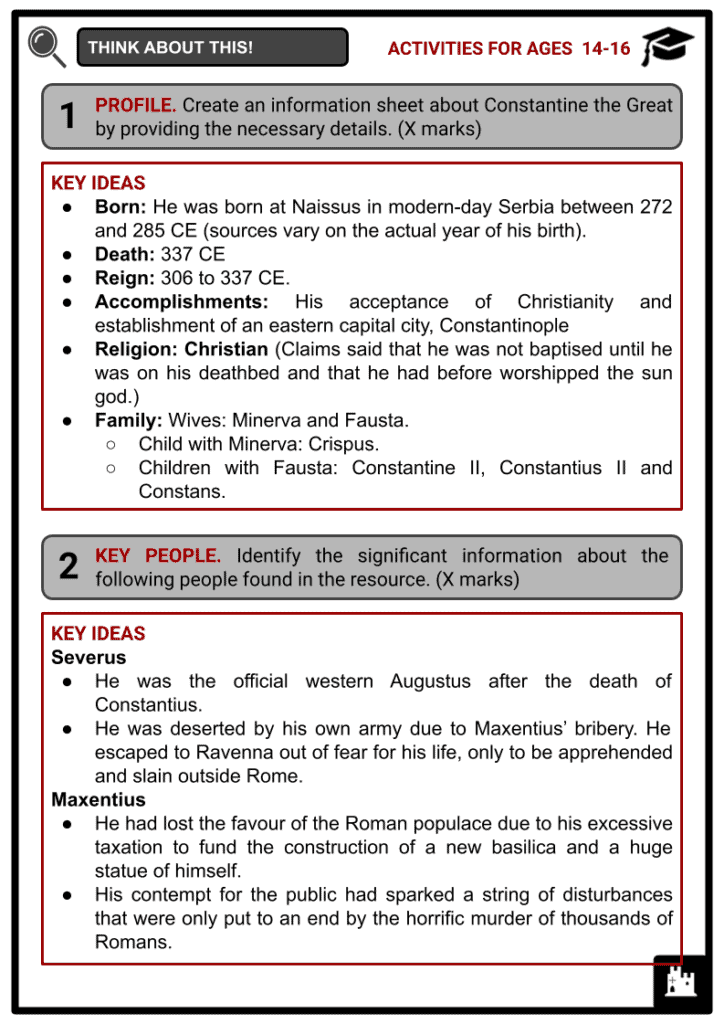Constantine the Great Worksheets
Do you want to save dozens of hours in time? Get your evenings and weekends back? Be able to teach about Constantine the Great to your students?
Our worksheet bundle includes a fact file and printable worksheets and student activities. Perfect for both the classroom and homeschooling!
Summary
- Early Life
- Reign as Emperor
- Byzantium (Constantinople)
- Christianity
- Death and Legacy
Key Facts And Information
Let’s find out more about Constantine the Great!
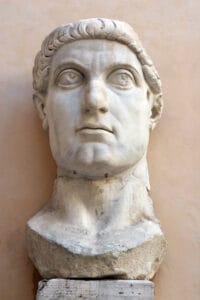
Constantine I, often known as Constantine the Great, was the first Roman emperor to convert to Christianity. He ruled from 306 to 337 CE. Before being summoned back to the west to battle alongside his father in Britain, he began his career by conducting campaigns in the eastern provinces (against barbarians and the Persians). He rose to power in order to extinguish all imposters to the throne and unify the divided empire. He did this by relocating the capital from Old Rome to a new eastern metropolis that would one day bear his name: Constantinople.
EARLY LIFE
- Gaius Flavius Valerius Constantinus was born at Naissus in modern-day Serbia between 272 and 285 CE, while sources vary on the actual year of his birth. Constantine spent all of his early years in the imperial court because his father was a military leader and the Caesar of the west. He later worked as a senior staff officer for Diocletian. Constantine was seen by everyone around him as a man with tremendous energy, even when he was young.
- Constantine got the chance to fight with his father in Britain against the Picts before Constantius passed away in York in July of 306 CE from leukaemia (the reason he was known as ‘the Pale’).
- When he invaded the Franks in 307 CE, Constantine continued to solidify his reputation as a leader who could act swiftly and decisively after the loss of his father.
- He demonstrated his capacity to act mercilessly by killing two Frankish kings and feeding them to beasts in the Trier amphitheatre (Augusta Treverorum).
- He could, however, also display sympathy, as when he returned previously seized church property.
- He gradually won the army’s respect by proving his men could trust him, even those who were more senior and experienced.
- The emperor taught him that a ruler’s duty was to protect the empire from any outside force and establish a just and orderly society, which Constantine would put into practice when he assumed the throne as emperor.
- Many believed that Constantine would be appointed the new western emperor after Constantius’s death and the victory of the war in Britain; however, Severus, a close friend of Galerius and a Caesar, was raised to the position despite the rumour that Constantius had named his son Augustus on his deathbed. Despite the formal ruling, Constantine was recognised as the Augustus by his men. Galerius, however, refused to accept this proclamation and referred to himself as Caesar.
- In October of 307 CE, Maxentius, who had been disregarded in 305 CE, declared himself Augustus while ignoring Galerius and Constantine. He ruled Sicily, Corsica, Sardinia and a portion of North Africa with the help of Rome’s populace and the praetorian guard. Up to six separate persons would eventually stake claims to dominance in the west.
- Because of their mistrust of Severus because of his closeness with Galerius, Constantine and Maxentius, Constantine’s brother-in-law, joined forces with Maximian, the previous Augustus, to overthrow the new Augustus.
- Unfortunately, Severus’ army deserted him once he was given instructions to stop Maxentius (having been bribed by Maxentius). He escaped to Ravenna out of fear for his life, only to be apprehended and slain outside Rome.
- Galerius’ army’s attempt to invade the west after his death was met with failure.
- On Diocletian’s urging, a new tetrarchy was established in 308 CE, with Constantine continuing to serve as the Caesar and Licinius, an officer in the Illyrian army and a close friend of Galerius, as the new Augustus.
- In 310 CE, Maximian, who had been serving as an adviser at Constantine’s court, came out of retirement, presenting himself as the new Augustus and asserting that Constantine had passed away, increasing the confusion.
- Maximian hanged himself out of desperation while Constantine, who had been overseas battling the Franks, pursued him outside Marseilles (the city had turned him away).
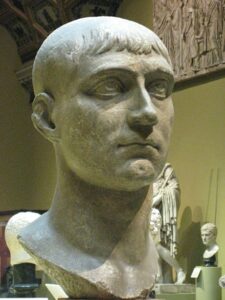
Maxentius - Meanwhile, Maxentius’ reign in Rome was coming to an end. Due to his excessive taxation of the Roman populace to fund the construction of a new basilica and a huge statue of himself, he had lost favour with them. His contempt for the public had sparked a string of disturbances that were only put to an end by the horrific murder of thousands of Romans. Constantine carefully awaited the western empire’s impending collapse before assembling a 40,000-man army and crossing the Alps to attack Italy.
REIGN AS EMPEROR
- Maxentius departed Rome in 312 CE to face Constantine in one last, decisive battle – the Battle of Milvian Bridge – with little help from the city. Constantine supposedly observed a cross of light in the sky the day before the conflict started. In Hoc Signo Vinces, which means ‘in this sign, conquer’, was written beneath it. He was given an explanation of the sign that night in a dream by Jesus Christ, who told him to carry the cross into battle. The following day, fresh flags bearing the Christian symbol took the place of the previous ones. Historians view Constantine’s conversion to Christianity as a historical turning point that united church and state.
-
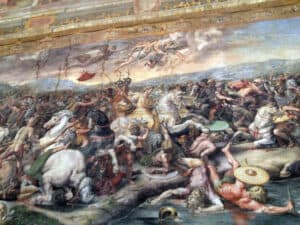
Battle of Milvian Bridge Despite being outnumbered, Constantine easily defeated Maxentius, who escaped back to Rome, but before arriving, he fell into the river and drowned; his body was discovered the next morning among the corpses of many others. Constantine took full control of the west right away. He entered Rome as the new Augustus in the west, and one of his first acts was to issue the Edict of Milan, which established religious tolerance (it would later be co-signed by Licinius).
- The eastern emperor at the time was Galerius, and the Caesar was Maximinus Daia.
- Maximinus and Licinius fought for control of the east after Galerius passed away from cancer (on his deathbed, he revoked all anti-Christian decrees), eventually splitting that region of the empire between them: Maximinus received Asia Minor and the eastern provinces, while Licinius received the Balkans.
- This agreement would not continue, and in 313 CE the two engaged in battle on the Thrace plains.
- Licinius battled under the cross, much like Constantine did at Milvian Bridge, but he did it mainly to win the support of the Christians because his rival, Maximinus, had vowed to exterminate them.
- Despite having fewer soldiers, Licinius prevailed, and after Maximinus committed suicide, he took control of the east.
- He quickly committed the execution of the family of Maximinus, the sons of Galerius and Severus, and even Diocletian’s daughter in order to feel comfortable and secure in his claim to the throne.
- Licinius and Constantine maintained an uneasy truce, in part because Licinius had married Constantine’s half-sister Constantia. In October of 316 CE, Constantine defeated him at Cibalae in their first combat. Following a second fight close to Hadrianopolis, Constantine received territory grants in the Balkans. Licinius’ attitude towards Christians evolved throughout the course of the following few years as a result of both executions and the destruction of numerous Christian churches. This was sufficient for Constantine to assemble an army and dethrone Licinius in a second conflict at Hadrianopolis.
- In order to get away from the Bosporus, the defeated commander left the battlefield. Licinius finally lost at Chrysopolis in September of 324 CE and gave up. Licinius wanted to live again as a private citizen, which Constantine originally permitted. However, he broke his word, and Licinius was executed by hanging in 325 CE, along with his nine-year-old son. With Constantine’s victory, the empire would be reunited.
BYZANTIUM (CONSTANTINOPLE)
- A sense of security returned when the empire’s 52-year-old Constantine was made the sole emperor. Old Rome was not the city Constantine desired for a capital, and in spite of various construction projects he initiated, it was in shambles. Nicomedia was never a viable alternative because it had been Diocletian’s capital, and Rome was no longer practicable (Constantine even disbanded the praetorian guard).
-
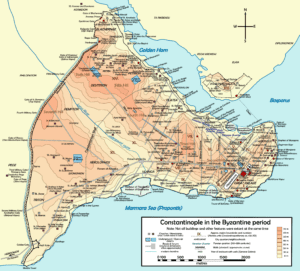
Map of Constantinople Though he considered the location of ancient Troy, Constantine realised that he needed a new capital and found one in Byzantium. The ancient city was strategically placed to manage travel to and from the Black Sea on the European side of the Bosporus Strait. It could also be readily protected because The Golden Horn offered a great harbour.
- He gathered craftsmen and materials from all throughout the empire to rebuild the city into the one he had envisioned. There were broad boulevards lined with statues of Constantine, Caesar, Augustus, Alexander and Diocletian. He constructed cisterns, Christian churches (Hagia Irene), pagan temples, and the walls were repaired. It was a classically styled capital that was also Christian. The city was finally dedicated the name ‘Constantinopolis’, meaning ‘Constantine’s City’ or Constantinople in 330 CE. The eastern part of the Roman Empire was becoming more significant. Constantine wanted the new capital to be built closer to the centre.
CHRISTIANITY
- While fighting in the west, he had consistently shown tolerance for other religions, including pagan and Christian people (he claimed to be a Christian since 312 CE). He dispatched his mother Helena on a trip to the Holy Land, where she had constructed the Church of the Nativity at Bethlehem after Constantine became emperor. Helena was a devoted Christian. While some claim Constantine was not baptised until he was on his deathbed and that he had before worshipped the sun god, he nonetheless gave every appearance of being a devout Christian.
- Despite the pagan symbols of Sol Invictus and Mars appearing on his coins, he is even given credit by many historians for declaring Christianity the official religion of the empire (although other historians give Emperor Theodosius this honour). While he approved of some pagan religious practices, he recognised that religious freedom had its limitations. As a result, laws were passed outlawing ritual prostitution and sexual immorality, banning pagan sacrifices, seizing temple treasures, and ending gladiatorial fights (which Christians disliked).
- At the Council of Nicaea in 325 CE, Constantine assembled clerics from all around the empire and made a case for unity.
- The outcome of the conference was the Nicene Creed, which defined what it meant to be a Christian in addition to condemning Arianism.
- Constantine’s religious faith was put to the test a year later, in 326 CE, when he had his own son Crispus (from his first marriage to Minervina), executed after being wrongly accused of adultery.
- Sources claim that Crispus, who had fought alongside his father and oversaw the western provinces, was the target of the charges made by Fausta, Constantine’s second wife, because she had fallen in love with him but he had rejected her.
- When it was eventually revealed that the claims were baseless, she killed herself. For the rest of his life, Constantine felt bad about what he had done.
DEATH AND LEGACY
- With the aid of his son Constantius II, Constantine the Great continued to lead the military, defeating the Alemanni in 328 CE, the Goths in 332 CE by starving them into submission, and finally regaining the lost Dacian territory (territories that were later lost after his death). After Shapur II, the ruler of neighbouring Persia, had invaded Armenia, his final wish was to capture that country. But this wasn’t to be as Constantine became ill and passed away in 337 CE. His reign lasted 31 years.
- Because of his illness, Constantine was aware of his impending demise. Constantine had secretly planned a last resting place for himself inside the Church of the Holy Apostles. It arrived earlier than he had anticipated. Constantine developed a terrible illness not long after the Easter Feast in 337. He departed Constantinople for the hot baths of Helenopolis (Altinova), the hometown of his mother, which is located along the southern beaches of the Gulf of Nicomedia (modern-day Gulf of Izmit). He prayed there, in a church his mother had built in honour of Lucian the Apostle, and there he became aware that he was passing away.
- His three sons, Constantine II, Constantius II and Constans, took control of the empire after his death. He was buried at the Church of the Holy Apostles in Constantinople. Constantius II eventually overcame his brothers and ruled the entire empire on his own.
- Constantine was regarded as one of the most illustrious historical characters in the Holy Roman Empire. The title ‘new Constantine’, which was bestowed upon ten emperors, including the final emperor of the Eastern Roman Empire, came to be regarded as a significant distinction in the later Byzantine state. Constantine gained a legendary status as a warrior against the pagans. During battles with the Sasanian Persians and the Muslims in the late sixth and early seventh centuries, his reputation as a saint appears to have extended across the Byzantine Empire.
Image Sources
- https://upload.wikimedia.org/wikipedia/commons/6/6c/Constantine%27s_head_at_capitoline_-_Flickr_-_cking.jpg
- :https://upload.wikimedia.org/wikipedia/commons/thumb/c/cb/Maxentius02_pushkin.jpg/460px-Maxentius02_pushkin.jpg
- https://upload.wikimedia.org/wikipedia/commons/d/d2/Room_of_Constantine_-_The_Battle_of_the_Milvian_Bridge_%2815462512410%29.jpg
- https://upload.wikimedia.org/wikipedia/commons/b/bb/Byzantine_Constantinople-en.png

